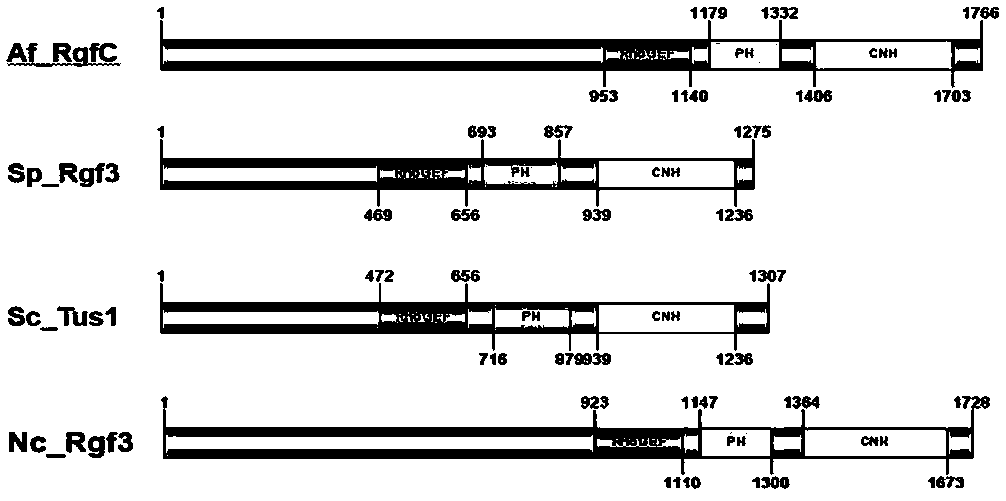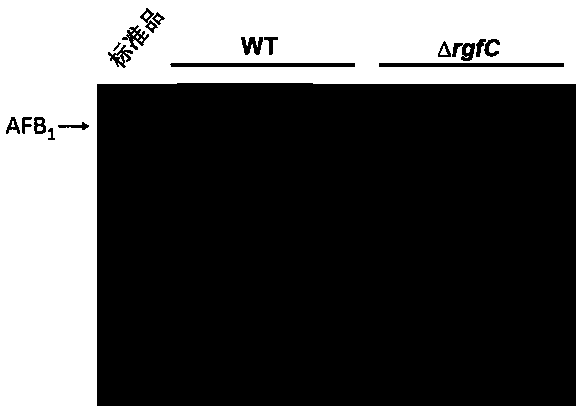Aspergillus flavus pathogenic gene rgfC and application thereof
A disease-causing gene, Aspergillus flavus technology, applied in the field of microbiology to achieve the effects of reducing usage, reducing toxicity, and shortening culture time
- Summary
- Abstract
- Description
- Claims
- Application Information
AI Technical Summary
Problems solved by technology
Method used
Image
Examples
Embodiment 1
[0061] Embodiment 1, in Aspergillus flavus gfC gene knockout
[0062] Aspergillus flavus gfC Gene function in Aspergillus flavus morphogenesis and virulence expression, first knockout in Aspergillus flavus gfC Gene.
[0063] figure 2 A shows the strategy for gene knockout. in vitro construction gfCGene knockout fragments, through the method of homologous recombination, the chromosome gfC The 5.4 kb DNA fragment in the gene was used pyrG replacement, thereby knocking out the chromosomal gfC Gene.
[0064] The specific method is as follows:
[0065] Using the 5' primer AAGCGGAACAACTCAGCGTAC (SEQ ID NO.3); and the 3' primer GGGTGAAGAGCATTGTTTGAGGCTCTGCTGGTGTCAGGGACTAAG (SEQ ID NO.4); the upstream fragment of about 0.9 kb was amplified by PCR from the genomic DNA of the Aspergillus flavus wild-type strain;
[0066] Using 5' primer GCCTCAAAACAATGCTCTTCACCC (SEQ ID NO.5); and 3' primer GTCTGAGAGGAGGCACTGATGC (SEQ ID NO.6); amplify about 1.9kb of A. fumigatus genomic DNA ...
Embodiment 2
[0069] Embodiment 2, gfC The Effect of Gene Knockout on Sporulation of Aspergillus flavus
[0070] Knockout in Aspergillus flavus by homologous recombination gfC Gene, Southern blot analysis confirmed that the knockout was successful. to detect gfC Whether the gene deletion will affect the spore production of Aspergillus flavus, the present invention cultured it on the PDA medium under continuous light or dark conditions at 29°C for 6 days, and observed the spore production of the following strains. The wild-type strain WT produced a large number of green spores, while ⊿ gfC No sporulation was observed in the deletion strain, and the statistical analysis of the data also showed this point ( image 3 A, 3B).
[0071] This result shows that, gfC The deletion of the gene will seriously affect the sporulation of Aspergillus flavus.
Embodiment 3
[0072] Embodiment 3, gfC Effect of gene knockout on toxin production of Aspergillus flavus
[0073] to detect gfC Whether gene deletion will affect the toxin production of Aspergillus flavus, the present invention inoculates spores in YESSB liquid medium (2% yeast extract, 15% sucrose, 1% soybean peptone, pH 5.5) to a final concentration of 10 5 cells / ml, cultured statically for 5 days under continuous dark conditions at 29°C, extracted the toxin, and analyzed the toxin production of each strain by thin-layer chromatography. The results showed that the WT strain produced a large amount of aflatoxin AFB1, while ⊿ gfC The production of AFB1 was not detected in the deletion strain, and the statistical analysis of the data also showed this point ( Figure 4 ).
[0074] The above results show that, gfC The deletion of the gene will affect the toxin production of Aspergillus flavus.
PUM
 Login to View More
Login to View More Abstract
Description
Claims
Application Information
 Login to View More
Login to View More - R&D
- Intellectual Property
- Life Sciences
- Materials
- Tech Scout
- Unparalleled Data Quality
- Higher Quality Content
- 60% Fewer Hallucinations
Browse by: Latest US Patents, China's latest patents, Technical Efficacy Thesaurus, Application Domain, Technology Topic, Popular Technical Reports.
© 2025 PatSnap. All rights reserved.Legal|Privacy policy|Modern Slavery Act Transparency Statement|Sitemap|About US| Contact US: help@patsnap.com



